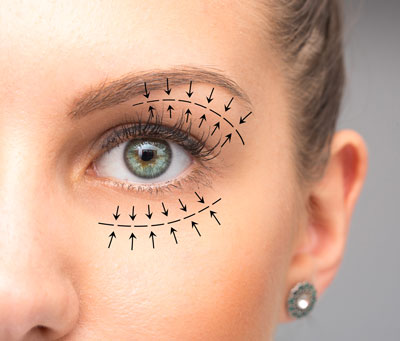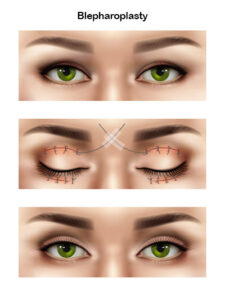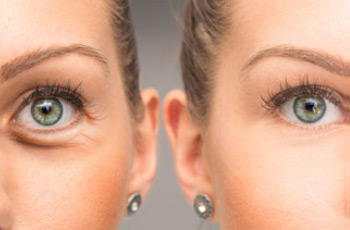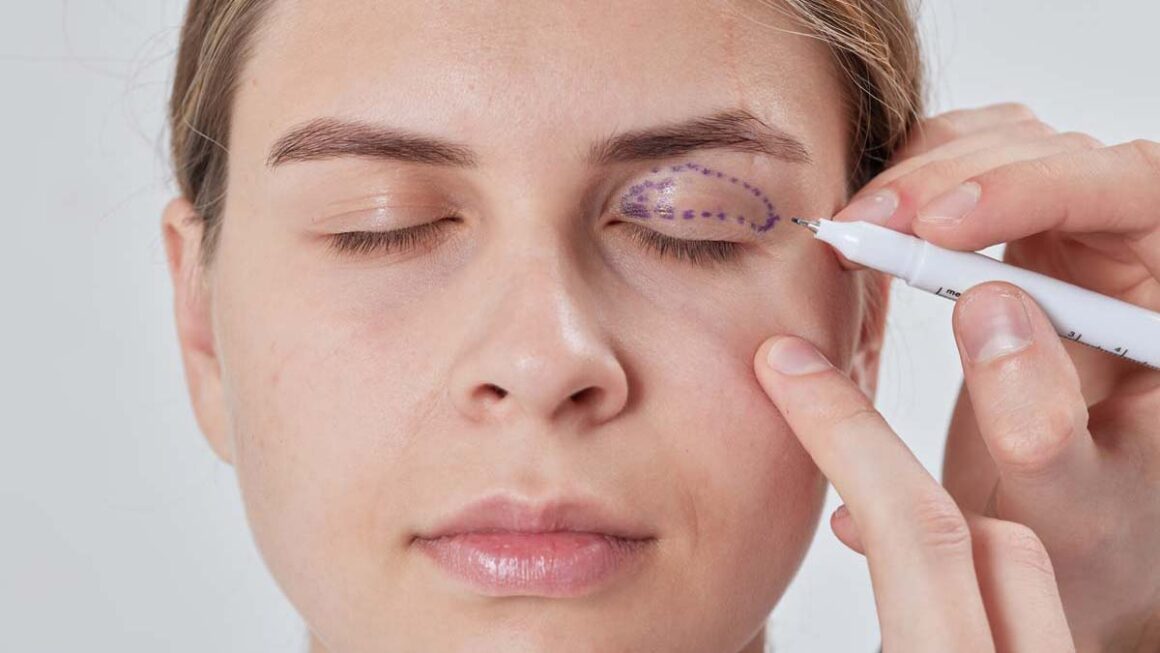Eyelid Surgery
Eyelid surgery, also known as ‘Blepharoplasty’, is the general name of cosmetic corrections performed on the eyelid. It is among the most frequently applied cosmetic procedures in recent years. In addition to the sagging of the upper and lower eyelids due to aging; eyelid surgery is also performed for sagging that can be experienced at an early age due to reasons such as genetics, trauma and infection.
 It is usually only the upper eyelid that is considered with cosmetic concerns. However, since droopy eyelids limit the field of vision, this is actually a functional problem rather than just an aesthetic issue. Therefore, drooping and sagging of the eyebrows due to structural damage or aging should also be evaluated together with eyelids from a functional point of view. Eyelid deformation may appear only as sagging skin, or it may be aggrevated with excess fatty tissue, sagging and drooping eyebrows. In these circumstances, droopy eyelids cause a tired and aged facial appearance and may impair the quality of life by narrowing the field of vision.
It is usually only the upper eyelid that is considered with cosmetic concerns. However, since droopy eyelids limit the field of vision, this is actually a functional problem rather than just an aesthetic issue. Therefore, drooping and sagging of the eyebrows due to structural damage or aging should also be evaluated together with eyelids from a functional point of view. Eyelid deformation may appear only as sagging skin, or it may be aggrevated with excess fatty tissue, sagging and drooping eyebrows. In these circumstances, droopy eyelids cause a tired and aged facial appearance and may impair the quality of life by narrowing the field of vision.
Eyelid surgery can treat excess skin of the upper eyelid; weakness of the subcutaneous tissues of the upper eyelid; herniations or collapses of the adipose tissue of the eyelids; sagging of the tear gland; sagging in the lower eyelid; fatty deposits and excess skin of the lowere eyelid; collapsed areas between the lower eyelid and the cheek; weaknesses in the lower eyelid ligaments. The decision about the extend of eyelid surgery will be determined after a detailed examination and the appropriate surgery should be attentively tailored for each patient. In regard to both aesthetic and functional reasons, eyelid surgery can be performed either only on the upper eyelid, lower eyelid or both together. In addition, brow lifts, forehead lifts and endoscopic mid-face surgery can be done simultaneously with eyelid surgery.
What is eyelid surgery?
Eyelid surgery is a set of surgical procedures applied to the upper and lower eyelids to remove sagging skin and excess fat, and to tighten the loosened tissues around the eyes.
Why is eyelid surgery performed?
Eyelid surgery is performed to provide both aesthetic and functional benefits.
Am I a good candidate for eyelid plastic surgery?
Generally, people over the age of 30, who have developed sagging and bagging of the lower and/or upper eyelids, who have healthy facial tissues and muscles, who have no serious eye diseases (glaucoma, retinal detachment, etc.) and serious health problems are suitable candidates for eyelid surgery.
What should I do before eyelid surgery?
Medications such as blood thinners, aspirin, painkillers and antibiotics, which might increase the risk of bleeding during surgery, should be stopped at least 15 days before the operation. Smoking, other tobacco products and alcohol use should also be stopped 2-3 weeks before, as they delay wound healing. Herbal supplements, fish oil, and vitamin E should not be used either during this period, as they may cause unexpected adverse effects.
Step-by-step surgery process:
Anesthesia: Local or general anesthesia.
Surgical procedure: Final measurements and markings are made on the operating table. For eyelid surgery, skin incisions can be made with the help of a scalpel, radiofrequency, electrocautery or a laser, depending on preference. After the removal of excess tissues, removal or replacement of fat, tightening and replacement of loosened tissues, the incisions are closed and the surgery is finished.
What should I expect after eyelid surgery?
There may be a slight tingling pain for a few days. Simple oral painkillers are usually sufficient. Swelling and bruising may be mild to moderate for 3 to 7 days. Swelling and bruising can be significantly reduced by applying ice at 48-72 hour intervals.
What should I pay attention to after eyelid plastic surgery?
Leaning forward, lifting weights, long walks are not recommended in the first days.
Do not drive a car for the first 3 days.
It is recommended to avoid water contact with the wounds for the first 4 to 5 days.
If non-absorbable stitches are used, the stitches are removed on the 5th day. No bandage is applied until the stitches are removed.
How long should I rest after eyelid plastic surgery?
Home rest is recommended for the first 3 days.
When can I return to work after eyelid plastic surgery?
You can easily return to your desk job after the 3rd day and to jobs that require physical activity after the first week.
 What is the recovery time after eyelid plastic surgery?
What is the recovery time after eyelid plastic surgery?
Recovery is seen in 7 days.
When can I wear contact lenses after eyelid surgery?
You can wear your contact lenses after one week.
When can I do sports after eyelid plastic surgery?
You can start walking as exercise after 2 weeks and running after 3 weeks. It is not recommended to swim for the first 2 weeks. Heavy sports can be started after the 4th week.
What results should I expect after eyelid plastic surgery?
In eyelid surgery, since surgery is performed without skin incisions or through hidden incisions, there is no or almost zero possibility of scarring.
Generally, a slight edema may persist for the first month. The final shape appears in the 3rd month.
Frequently Asked Questions
With the effect of the loosening of connective tissue and skin with age, the eyelids begin to sag due to gravity. In addition to aging, findings such as bagging of the eyelids, loose skin, discoloration, loosening and wrinkles may also contribute. Moreover, injuries, infections, allergic diseases, tumors, some muscle or nerve disorders might cause droopy eyelids.
Leaning forward, lifting weights, long walks are not recommended in the first days. You should not drive a car for the first 3 days. It is recommended not to get water on the wound areas for the first 4 to 5 days. If non-absorbable stitches are used, the stitches are removed on the 5th day. No bandaging is applied until the stitches are removed.
Most commonly, with the effect of aging, the eyelids begin to sag due to gravity with the loss of connective tissue support.
As with any surgery, bleeding and infections may develop, albeit very rarely. In the absence of meticulous preoperative evaluation and planning, asymmetry may also occur.
The skin, which normally has an elastic structure, gradually loses its elasticity as it ages. Loosening on the skin, which is the first sign of this loss of elasticity on the face, is seen on the eyelids. The loose skin on the eyelids causes drooping of the upper eyelid. Aging is accelerated by factors such as exposure to sunlight, air pollution, irregular sleep, excessive smoking and alcohol use.
The advantages are that the surgery is short, complications are rare, scars are almost absent and its effectiveness is long-lasting.
Age-related changes in the eyelids cause a tired, dull and older appearance. Some of the signs of aging seen on the eyelids are;Upper eyelid drooping,Bagging and discoloration under the eyes,Wrinkles and sagging of the eyelid skin,Crow’s feet lines in the corners of the eyes,A tired facial expression.
The effect of eyelid aesthetics is permanent for many years. However, at very advanced ages, re-intervention may be required because aging cannot be stopped.
The degree of sagging of the eyelids increases with age. Since this causes a decrease in the field of vision, both aesthetic and functional problems related to droopy eyelids worsen.
The most obvious symptom of droopy eyelids is sagging of one or both upper eyelids. This drooping may be mild or very pronounced. Droopy eyelids cause a tired and unhappy appearance on the face.
The most common cause of droopy eyelids is aging. If you fight against factors that accelerate the effects of aging such as exposure to sunlight, air pollution, irregular sleep, excessive smoking and alcohol use, you can slow down the process of droopy eyelids.
Droopy eyelids cause narrowing of the field of vision; headaches and a tired, unhappy appearance.
If the drooping of both upper eyelids is severe, it narrows the field of vision. To reduce this problem, the eyelid and forehead muscles will overwork and get tired, which in turn may cause headaches.
Generally, people over the age of 30, who have developed sagging and bagging in the lower and/or upper eyelids, who have healthy facial tissue and muscles, who have no serious eye diseases (glaucoma, retinal detachment, etc.) or other serious health problems are suitable candidates for eyelid surgery.
Although the problem of droopy eyelids is seen in older people due to aging, the ideal age for eyelid surgery is the age at which the person finds the problem disturbing.
If droopy eyelids cause aesthetic and functional problems, it is considered that the person needs eyelid surgery.
Droopy eyelid can be treated with surgical and non-surgical methods. Non-surgical eyelid correction methods are mainly; – Botox, -Fillers – Radiofrequency – Ultrasound – PRP – Laser – Chemical peeling – Plasma therapy – Thread applications. However, none of these treatments can be a replacement for surgery in patients who require surgery. Sometimes some of these techniques can be used in addition to surgical treatment. Especially botox and filler applications may sometimes accompany surgery.
It can help in cases with mild eyelid sagging. However, the effect is temporary. It requires repeated applications.
Fillers can help in cases with mild eyelid sagging. However, the effect is temporary. It requires repeated applications.
The best and permanent treatment for droopy eyelids is eyelid surgery.
Eyelid surgeries can also be performed with local anesthesia.
Eyelid surgery that will require only local anesthesia can also be performed in the office.
Eyelid surgery takes between 1 to 3 hours.
Bleeding and infection are very rare. In the absence of meticulous preoperative evaluation and planning, asymmetry may also occur.
Mild to moderate swelling can be seen between 3-7 days. Generally, mild swelling may persist for the first month.
Leaning forward, lifting weights, long walks are not recommended in the first days. Do not drive a car for the first 3 days. It is recommended not to get water on the wounds for the first 4 to 5 days. Smoking and alcohol consumption should be stopped as they delay wound healing.
For the first 4 to 5 days, it is recommended to avoid water contact with the wound sites. Therefore, you can take a shower on the 3rd day, carefully avoiding getting water on your face.
It is not recommended to enter the sea or pool for the first 2 weeks.
You can apply makeup 5 days after eyelid surgery.
You can wear your contact lenses after one week.
If non-absorbable suture material is used, these are removed on the 5th day. Afterwards, light make-up materials that dissolve in water and flow spontaneously in the shower can be used to camouflage edema and bruising around the eyes.
Recovery is seen 7 days after eyelid surgery.
It takes 10-14 days for the scars of eyelid surgery to heal.
The final shape appears in the 3rd month.
The effect of eyelid surgery is permanent for many years. However, at very advanced ages, re-intervention may be required because aging cannot be stopped.
To get rid of bags under the eyes, you should sleep 7-8 hours a day,sleep with the head elevated,avoid liquid consumption and salty foods just before going to bed,and apply moist, cool compresses on the eyes while sitting. In cases which do not respond to these, surgery is recommended.
Almond eye surgery’ (Cantoplasty) is a cosmetic surgery that removes sagging on and around the eyelids and gives the eyes a slanted appearance. Almond eye surgery is among the most popular aesthetic surgeries. It can be applied to both sexes. In this way, it is possible to achieve a younger, vibrant and healthy facial appearance.


Leave a Reply
You must be logged in to post a comment.